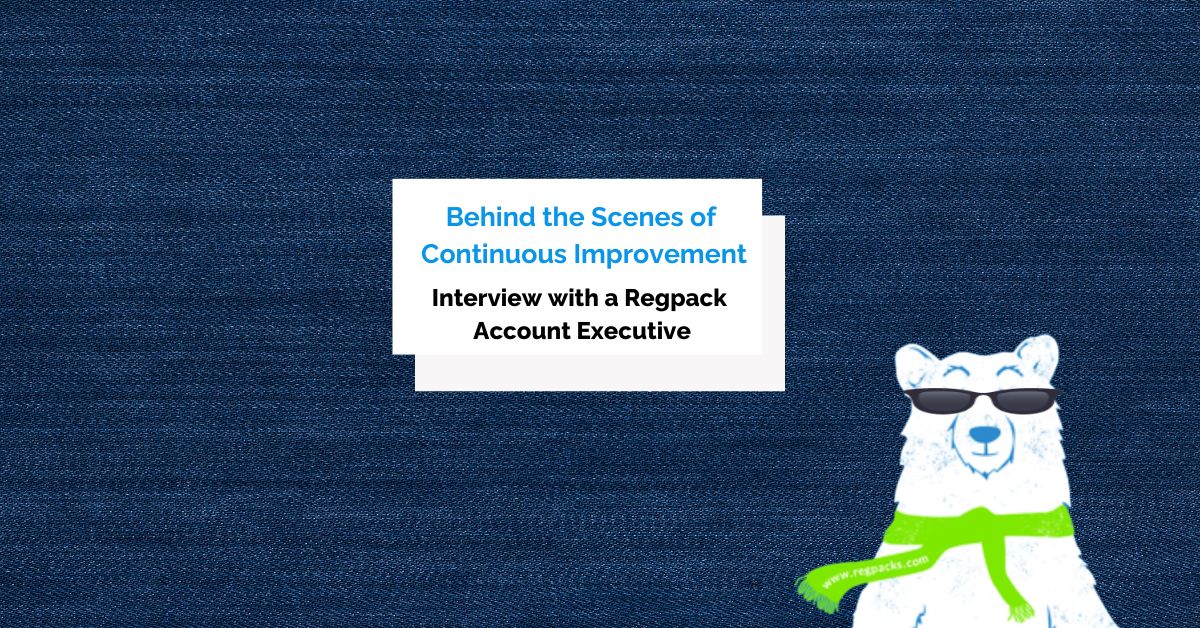Sending dunning emails is not the most exciting thing in the world. The very definition of the word ‘’dunning’’ means making repeated or insisted demands, which triggers fight or flight mode in many people.
Dunning emails remind people of their finances, which can be very stressful. When you combine that initial stress with a rude or demanding email you can alienate customers from your company and product.
Nobody wants to be the bad guy. You obviously want to have great relationships with your customers and see them reach their goals with your product. But you also want to get what you’re owed for making that happen.
The solution is to start sending better dunning emails.
Luckily, you can do several simple things to improve your dunning emails without damaging your relationships with customers.
Read on to find out more.
What are Dunning Emails?
Dunning emails are account-related messages that alert customers about overdue invoices, failed payments, or card expirations.
Simply put, dunning is the process of asking customers to pay what they owe to your company.
Now, it’s relatively easy to put all the blame on the customer and think they’re out to scam you (they’re not, at least, 99% of them aren’t). So, before you start writing passive-aggressive emails and demanding your money, you should know that customers often aren’t even aware of failed payments.
These failures happen because of card declines. Sometimes your customer will lose the card and have to get a new one, forgetting to update the card information. In other cases, they won’t have enough funds, or their credit card information will happen to be outdated.
Whatever the reason, you’ll need to inform them to update their billing information. That is where dunning emails become useful.
Here’s an example of a typical dunning email:
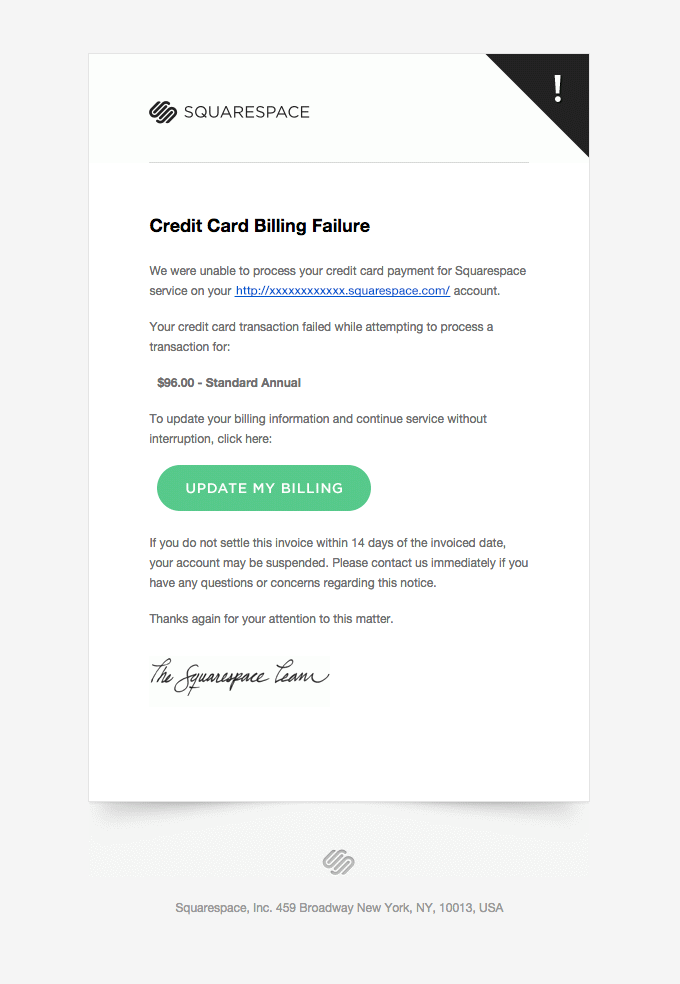
Source: Customer.io
Squarespace covered all the basics in a very short email.
They were clear on what happened (a billing failure) and instructed the customer on what to do next if they want to continue using the product. Customers can click on the CTA button or ignore the email. If they ignore the email, they’re warned about the consequences (their account will be suspended).
The most important thing about dunning emails is to explain what happened and how to rectify the situation.
If you send emails like these, you can expect a lower churn rate. Churn happens because customers don’t renew their subscriptions, which won’t happen if they can’t pay for a product. Your mission is to actively reach out and fix this situation.
So, use dunning emails to recover revenue before you lose your customers forever.
Tips for Sending Better Dunning Emails
We know dunning emails are essential for recovering revenue. Now, our next problem is how to write them effectively. You will have to take a closer look at how your subject line, email body, and conclusion affect your customers when they open their emails.
Here are some of the best ways to improve your dunning emails to ensure your customers quickly pay for your product.
Write Emails With Empathy
Your main goal is to get paid, but the tone of your emails can significantly impact the customer’s decision to continue doing business with you. They might settle their current bill, but if you’re unfriendly and rude in your email communication, they will later cancel their subscription.
Remember that mistakes happen to anyone, and you should always assume that failed payments also happen unintentionally.
Keep in mind that your customers are just people. Emotions drive their actions, so they will fight back if you approach them with hostility. For your business, that will mean a loss of revenue because users won’t renew their subscriptions the next time.
Customers’ emotions are even more heightened when it comes to money. Handling finances is stressful in itself, but when customers are reminded of financial mistakes, their anxiety can spike. Your best solution is to approach in the friendliest manner possible.
Here’s an example of a very effective and friendly dunning email:
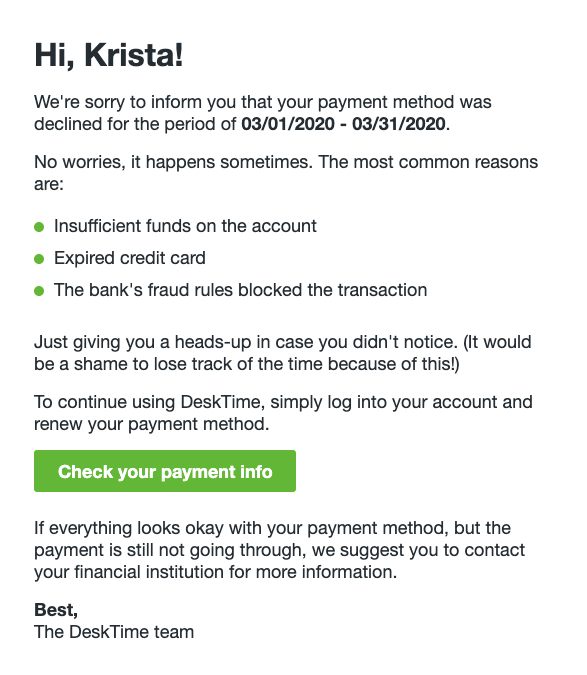
Source: Baremetrics
DeskTime took great care in using a reassuring tone in their email copy. They informed their customer of what happened, but they quickly emphasized that it was not the customer’s fault. They even list other possible reasons failed payments happen.
DeskTime is an automatic time tracking software, so they used humor to alleviate a tough situation (‘’It would be a shame to lose track of time’’). This is a commendable practice as it might win over the customer and calm them down.
Furthermore, they explained what the customer should do next while remaining professional and polite.
DeskTime understands that you should be mindful of how you interact with customers at every point in your business relationship. Customers might have chosen DeskTime’s product to solve a problem, but they stuck with them because of the overall experience DeskTime provides.
Receiving such friendly emails can significantly improve the customer experience, even when bad things happen. And you know what happens when customers are happy with your company? They tend to spend more and increase their lifetime value.
Being friendly can literally pay off in the long run.
Remind Customers of the Benefits They Could Lose
Just being friendly won’t get you far if you don’t pair that with a sense of urgency. While you might’ve calmed the customer with a polite email, there is still a chance they will ignore it.
If you want to keep their attention and make them click on that CTA button, you have to use a bit of psychology.
One tactic to use is loss aversion. This refers to the idea that the fear of losing something is far greater than the desire to gain something. For example, people will be more affected by losing $10 than by receiving $10.
While it might not make too much sense, it’s something you can use to your benefit. In your dunning emails, you have to emphasize which benefits the customer will lose if they don’t sort out their payment. This should entice them to act immediately.
Here is how New York Times evoked loss aversion:
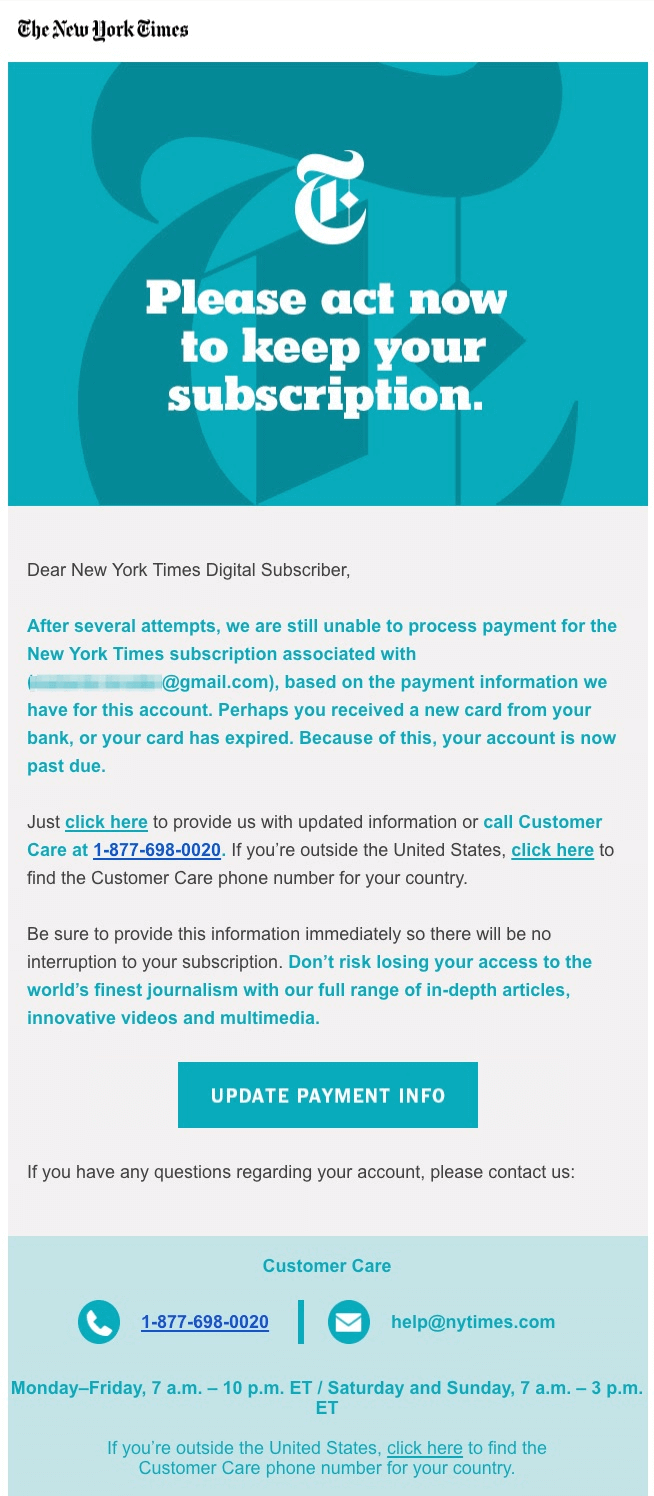
Before the “update payment info” button, they emphasized in bold all the benefits of their subscription that the customer had so far.
Why is that important? Because the customer now fears they won’t read amazing articles and watch NYT videos anymore! They will lose something valuable, and that will spur them into action.
So, what can you learn from this example? First, you have to evoke strong emotions in your customers. Use impactful words that will create a sense of loss and urgency. The New York Times used emotional and powerful words like ‘’risk’’, ‘’immediately’’, and ‘’losing’’.
Then, you have to be specific about the benefits customers are losing. Focus on the core features they frequently use and emphasize how much their lives are improved with your product.
If customers think they’re going to lose something they need, they are far more likely to update their billing info right away.
The bottom line, it never hurts to remind customers why your product is amazing and why they should continue using it.
Set up a Return Email Address
If you’re still sending emails from a dontreply@domainname.com, you’re telling your customers that they’re not important to you.
Businesses increasingly want to optimize their processes so they heavily invest in automation. This can result in a very impersonal approach to customer service, which customers don’t want.
They want human contact and a personalized approach.
In fact, almost 60% of North American customers react more favorably to personalized emails.
They want to be seen by a company, and they don’t care that you have thousands of other customers. Their experience is the most important to them.
When they get customized emails, they can convince them to act faster and click on your CTA more frequently. They will more likely update their billing information immediately.
So, when you send your dunning emails, you should keep two things in mind. The first is to make sure they’re being sent from an actual employee from your company, like Mailshake, an email outreach SaaS company, does.

This shows you’re more accessible as a company and that you have an individualized approach to business. You’re proving that you take care of each customer as a person which only strengthens trust in your company.
The second thing is to set a return email address. Your customers will probably want further clarification about the dunning email they received.
So, when they don’t have an address they can reply to, or even worse when they have to find your company’s contact information on their own, you’re causing unnecessary frustration.
Demonstrate you care about their business with your company and make it easy to contact you if they have any questions or concerns.
You can copy Nifty’s dunning email in which they provided an email address, link to customer service, and a telephone number. They’re going the extra mile to cater to customer’s preferences, but sometimes an email address is enough.
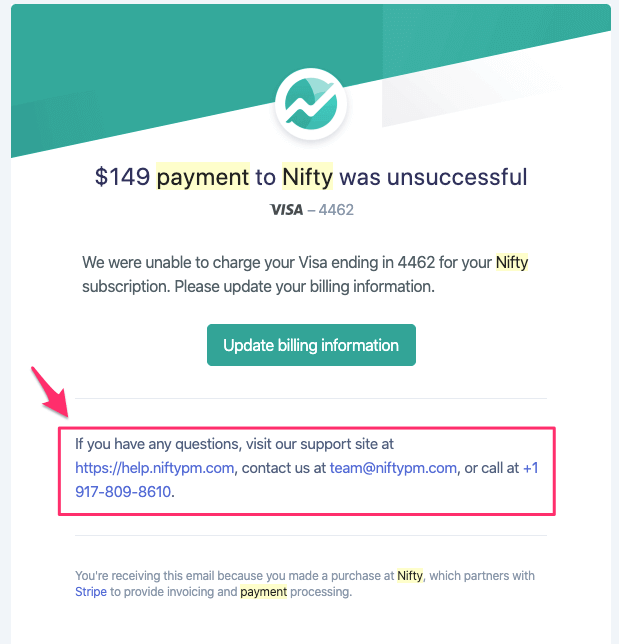
Source: Baremetrics
Show your customers they can trust you even in times of trouble so add important contact information in your emails.
Optimize the Subject Line
Are you familiar with this picture?
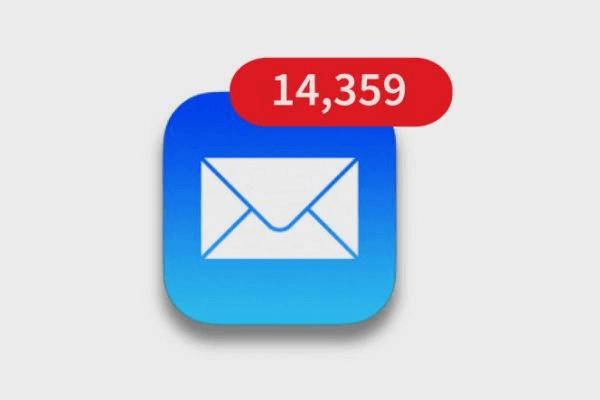
Cluttered email inboxes are a reality for many people, and it’s getting more difficult to get them to open relevant emails.
Not convinced? Look at some of this data from Campaign Monitor. In 2020, because of the pandemic, marketers have turned to emails to make the most of their marketing efforts.
To this day, emails remain the best way to reach customers and provide them with the information they need about their products. So, that resulted in a billion more emails being sent in 2020 than in the previous year.
As you can imagine, when people use emails to access information more frequently, open rates will jump as well. In fact, open rates increased by 13% in 2020.
Logically, more open rates mean more engagement with brands and increased business, right? Well, not quite.
Campaign Monitor actually reports that click-through rates have stayed the same as in previous years, despite an increase in sent emails. One of the main reasons was that people simply ignored their inboxes because they got too many emails.
In fact, people only opened 1-2 emails on average. If you have to recover lost revenue, these stats are going against you.
So, what can you do about it? You have to optimize your subject line. This is the first thing customers see when skimming through their inboxes, so that’s your priority.
You should use language that will evoke a reaction in your customers. Words like ‘’declined’’ or ‘’failed’’ are a sure way to get their attention. But don’t forget to include the phrase ‘’Action required’.’

It may seem obvious to you what your customers need to do, but they still didn’t open your email, so they don’t know what went wrong.
Use five words or less to grab their attention and get them to open your email. Then you can explain what the ‘’required action’’ is.
If your subject line doesn’t get them to click your email, you won’t get paid. Your dunning emails are not notifications. They require engagement, so you should drive recipients to take action.
Keep it Short
Nobody wants to read a twenty-page email about how their payment failure affects your company.
Remember that dunning emails serve one purpose: to get your customers to take immediate action and update their billing info. So, it’s vitally important that you make these emails short and straightforward.
How do you do that? The general advice is to keep the email copy under 100 words. You should only explain two important things: what happened and what needs to happen next. That’s all.
Mailflow understands how to get a clear message across.
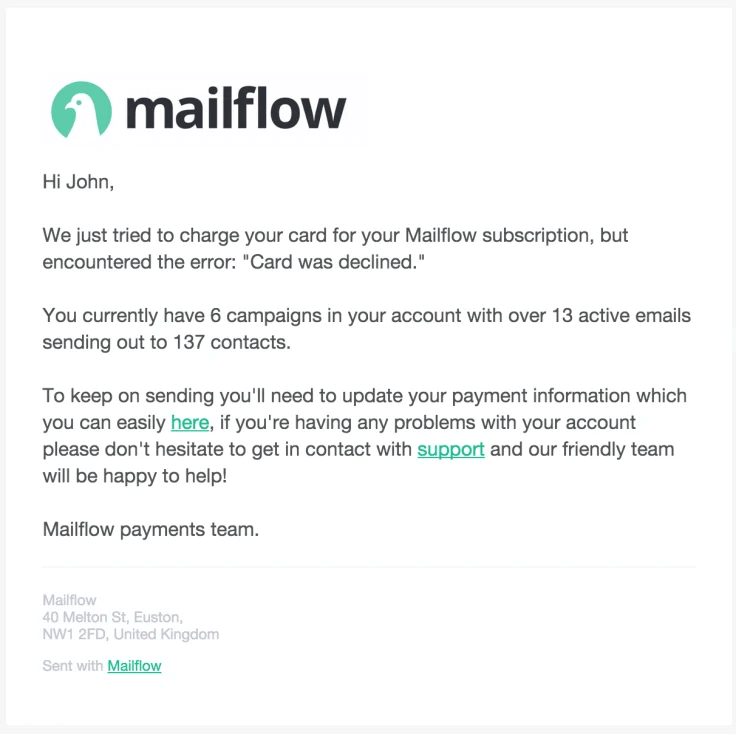
Source: Rebilly.com
They explained what happened in one sentence and provided helpful links so the customer can take action right away.
Also, they emphasized the urgency of this situation by providing additional info about their customer’s account status. So, if the customer ignores Mailflow’s email, there are serious consequences – they won’t continue their email campaigns.
Their entire dunning email consists of five sentences in which they provided all the essential information. They kept it short and to the point, which is what you should do as well.
Essential information and clear formatting are the most important aspects of crafting perfect dunning emails.
Make It Easy to Pay
If you require customers to put in their login information after you’ve spurred them into action, you’re slowing down the payment process. You want them to update their billing information, so why are you making them jump through hoops to do it?
The entire reason you’re sending dunning emails is to solve payment issues. So, you should enable your customers to do that with just a few clicks.
Take into account that they might be using a different device that doesn’t store their login information. Also, consider that they’ll likely forget their password and decide to deal with this later. This means they’ll probably forget about you, and you’ll have to deal with customer churn on top of everything else.
Think of it this way.
If they’re accessing your product through a verified email you have in your database, why do they need to reconfirm their identity? It’s just another roadblock to the payment process that doesn’t benefit anybody.

Google’s G Suite requires users to log in to update their payment information
Simply get them to the payment page through a CTA button in your dunning email to complete the process. This shouldn’t take them more than a minute, but you should warn them in your email copy if it does.
There’s another thing you should consider, and that is optimizing your payment updating for smartphones.
If you look at the share of web traffic by the device for over 4.7 billion Internet users, you’ll see that a lot more people access the Internet via their smartphones.

Source: Hootsuite
You can bet they’re also looking at their emails and want to update information using their smartphones. So, don’t forget to optimize your payment page for mobile users. With this, you’re also giving them more options and ease of use which they’ll appreciate.
The easier you make this process, you can get paid faster, and your customers will be happier to continue doing business with you.
Automate Your Dunning Process
Automated solutions can help you in numerous ways without compromising your relationships with your customers.
First, you increase your chances of recovering revenue. Systems will automatically detect overdue invoices and send dunning emails to the right customers. That way, you get paid on time and increase your cash flow.
Another benefit of automated dunning systems is that you can send multiple emails. Regpack has a highly intuitive payment processing system that can help you automate everything and request payments easily.
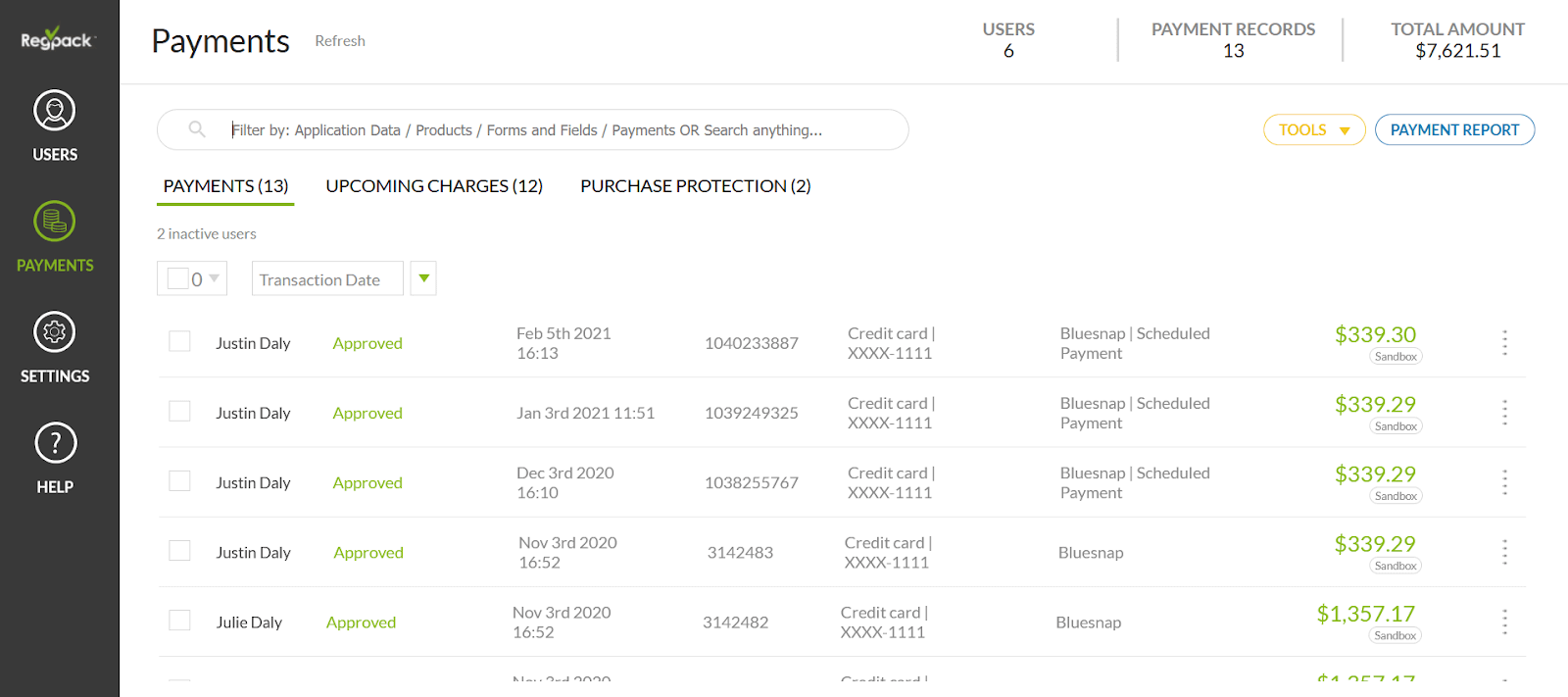
Let’s face it, even if your customers are willing to pay, the likelihood they’ll do it after the first dunning email is slim. They are busy, and they’ll probably need a couple of reminders.
Look at this table from Baremetrics, which analyzed emails from their customers.

They didn’t stop at one dunning email, and they recovered more revenue with each new email they sent. Obviously, the dunning was the most successful with their first attempt, but imagine if they only sent that one! The remaining customers would be extremely late with their payments or not paid at all.
You have to be persistent when you’re hunting down failed payments.
Some of your customers will react to your first email, but not many of them will. So you must have a scheduled dunning email sequence to recover as much revenue as possible.
Ensure your emails get delivered to the right person with an automated dunning email solution so you can increase your cash flow.
Conclusion
When you know that 78% of customers use email for their daily communication, then you know it’s easy to reach them via email to inform them about their failed payments.
Just be sure to follow the tips we outlined in this article, and your dunning emails will be well received.
If you’re lucky, your customers will rectify their mistakes immediately, but you also have to consider different obstacles in this process. People receive many emails each day, so it’s important to catch their attention from the minute they open their email inbox.
Optimization and persistence in sending dunning emails are the only solutions to get the money you’re owed.



